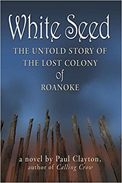
 |
Maggie Hagger is just one of many passengers leaving England and making her way to Chesapeake, Virginia, in 1587 as one of the future citizens of Sir Walter Raleigh’s colonies. Raleigh’s Virginia promises the start of a new life to Maggie and others—like the newly appointed Governor John White, as well as Captain Stafford and his soldiers—but first, they must survive the journey to the Americas. Yet Maggie and the other colonists soon learn that settling down in Chesapeake will be much harder, as tensions between the Native American tribes there and prior English settlers still exist. Labeled as one of America’s oldest mysteries, the failed colony of Roanoke is at the heart of this novel, which explores the possibilities of what went wrong and what happened to the inhabitants.
Readers do not need to be history buffs to enjoy Clayton’s tale; it is well-researched and presents many of the political and economic issues at hand without being overbearing on context. On a surface level, the journey to the Americas is a chance for colonists to establish a new life overseas. Beyond that, a successful establishment of the colonies would grant more power to Sir Walter Raleigh and England, who were in direct competition with Spanish explorers, as well. The Spanish believed that gold from the New World would be the key to riches and success, while England’s goal was to establish outposts for trading goods. The author emphasizes this point, particularly when Fernandes—the sailor and navigator hired to help bring the English to Chesapeake—dumps the colonists in Roanoke to continue his search for “prizes."
Clayton captures early colonial and early Native American life well. The novel is full of rich detail about many of the tasks of building or maintaining a society, and there is a sense of excitement as the colonists get settled and get their bearings, even though the future is uncertain. The author sets up the novel in a clever way that has the reader rooting for both the members of the Roanoke colony as well as the Croatoans. The relationships between the colonists and the Native American tribes on the land is a delicate one, and the author does a great job at showcasing the many different attitudes that exist between the three groups of inhabitants there: the Croatoans, the Secotan, and the colonists. Tension exists between all three due to acts of violence, fear, and power. But there is also love, as well as alliances, as exhibited by the blossoming relationship between Maggie and Manteo, the Croatoan interpreter.
This is a story about ambition, power, and survival, and the slow and steady decline of morale and trust in each other is fascinating and horrifying as it plays out page by page. Hope and survival are at odds with each other as the colonists make attempts to carry on civilly, but many of their efforts are futile once the soldiers’ mutiny is complete. The end of the novel is especially haunting, as the author hints at what may have transpired to cause Roanoke to disappear.
Next Focus Review
Previous Focus Review